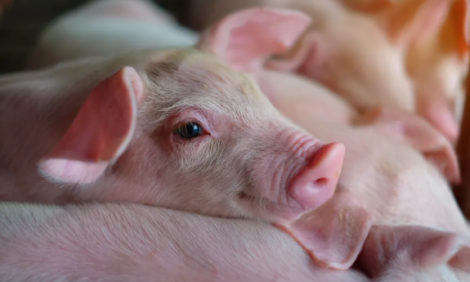



Economics of vaccination in a changing market
By Dr's Hardge and Schuetz, Boehringer Ingelheim, Germany - Mycoplasma hyopneumoniae induced enzootic pneumonia is a costly disease in grower pigs. For many years vaccination has been shown to be an appropriate tool to reduce both clinical signs and economic losses, but the benefit to cost relationship still needs to be carefully considered.
During unprofitable market situations it is particularly questioned whether the benefits of vaccination justify the costs.
On a French farrow-to-finish farm with 170 sows an efficacy study was carried out for a single-shot Mycoplasma hyopneumoniae (M. hyo) depot vaccine. From the results, the economics of vaccination were
analysed. Using a stepwise reduction/ increase procedure for slaughter prices and feed costs the effect of varying market situations could be included.
On the farm, respiratory disorders had been observed, including coughing for several months, and the presence of M. hyo was confirmed by antigen immunofluorescence. Three successive batches of pigs were
included in the study. Each batch was randomly divided into vaccination and control group and housed
in the same room in pens of 12 to 14 pigs and fed liquid feed. The piglets were vaccinated before introduction into the fattening unit (10 weeks of age) with a single dose of 2ml Ingelvac® M. hyo. The control group received 2 ml isotonic saline solution by intramuscular injection. All finishers were sold as a batch without any weight selection. The trial farm was exceptionally well managed with an excellent average performance level.
The increased prevalence of serum antibodies towards the end of the fattening period, both in the vaccination and control group, suggests that the natural challenge with M. hyo took place in the middle of the growing period (Figure 1).
|
Figure 1: Sero-conversion in the control and vaccination group during the growing period

|
Effect on health and performance
The significantly lower pneumonia frequency of the vaccinated group clearly demonstrates the efficacy of the vaccination (Table 1). Compared to the high pneumonia prevalence the mean lung lesions score of
affected lungs was relatively low. This is probably influenced by the fact that lung lesions can heal before pigs reach slaughter age (Wallgren et al, 1994).
The 18g improvement in post-vaccination daily weight gain and the better feed conversion (-0.11) is in close agreement with results of a metaanalysis of a field study including 14 farms infected with M. hyopneumoniae (Maes et al, 1999). The mortality in the control group was at 7.9% relatively high. This is partly influenced by an acute E. coli infection in one of the batches where 5 out of 55 animals
died four weeks after introduction; none of the vaccinated animals died, which shared the same room. The mortality was not considered, however, in the further economical analysis of vaccination.
|
Table 1: Respiratory health and performance traits in the control and vaccination group

|
Economic analysis
|
Table 2: The influence of vaccination on net sales, cost and gross margin

|
As a result of better performance the vaccinated group had a higher gross margin than the unvaccinated controls. This is particularly remarkable since the vaccinated groups shared one room with the control animals, which might increase the infection pressure for the vaccinated pigs and decrease the pressure on the controls. In total, the financial advantage of vaccination, including vaccination costs, was as high as €3.10 per pig (Table 2). This amounts to a marginal benefit to costs ratio of €2.07, i.e. per €1 spent on vaccination the increase in the gross margin was €2.07.
The economic effects of vaccination are based on lower feed costs (-€0.80) and more sold (+€3.50). Interestingly, about 43% of the higher net sales (€1.52) are a clear effect of the better uniformity of the vaccinated group (lower sort loss). Pigs of the vaccinated group had a lower sort loss (€1.78) at slaughter than unvaccinated pigs (€3.30).
Varying market prices...
Economic losses attributable to M. hyo infections are associated with reduced rate of weight gain and feed efficiency (Ross, 1999). Vice versa the economic value of vaccination is based upon higher sales due to better growth and lower feed costs. Variation in feed price and the realised price for the fatteners sold largely contributes to the profitability of fattening. In order to simulate the influence of varying prices, the gross margin and vaccination benefit has been recalculated using a
stepwise increase in slaughter price and feed costs. Table 3 summarises the applied price variations.
The vaccination benefit as percentage of the gross margin demonstrates the economic importance of vaccination in different price systems. A higher value shows that the vaccination benefit contributes economically more to the respective gross margin. Not surprisingly, an increasing slaughter price leads to an increased gross margin (Table 3). In accordance with Maes et al (1999) the benefit of vaccination increases with increased slaughter price. This is mainly due to higher sales, which could be realised
by vaccinated pigs. Interestingly, the share of the vaccination benefit in the gross margin is higher (40.5%) in a low slaughter price situation than in the assumed high price situation (4.7%). Therefore, the lower the slaughter price, the greater the influence of vaccination on economic benefit (Figure 2).
|
Table 3: Range of values used for slaughter and feed prices

|
...And increasing feed costs
Increasing feed prices will lead to a reduction of the gross margin per pig. Because of a better feed efficiency and lower feed costs, vaccinated pigs are economically less affected by a higher feed price than unvaccinated pigs. This can be shown by the increased vaccination benefit with higher feed prices. But most remarkably, the higher the feed price the higher is the relative importance of the vaccination benefit as percent of the gross margin (Figure 3).
General rules
The relative economic importance of vaccination increases in situations where profitability is under pressure. This is mainly due to the fact that the vaccination benefit is a biological effect, which is relatively independent of the overall price situation. Vaccinated pigs will have a lower sort loss, higher weight and a better feed conversion rate, independent of the market situation.
Here, it could be shown how M. hyo vaccination contributes relatively more to the gross margin when
slaughter prices are low and feed prices high. This is unexpected and somewhat surprising since economic arguments are often used to delay or stop vaccination in unprofitable market conditions. Our results contradict this point of view. Even in market situations where producers are losing money, they would lose less by vaccinating. Obviously an important pre-condition is that the vaccine used is able to efficiently reduce the clinical signs and improve the economically important performance traits.
|
Figure 2: Relationship between gross margin and vaccination benefit with increasing slaughter price

|
|
Figure 3: Relationship between gross margin and vaccination benefit with increasing feed price

|
References
Livestock & Meat (2002): German pig trade fails to sizzle. Livestock & Meat,
193, 19
Maes, D.; H. Deluyker, M. Verdonck, F. Castryck, C. Miry, B. Vrijens,W. Verbeke, J. Viaene, A. De Kruif (1999): Effect of vaccination against Mycoplasma hyopneumoniae in pig herds with an all-in/ all-out production system. Vaccine 17, 1024 – 1034
Ross, R.F. (1999): Mycoplasmal Diseases. Diseases of Swine. 8th Edition, p 495 –503;
Wallgren, P.; P. Beskow , C. Fellstrom, L.H. Renstrom (1994): Porcine lung lesions at slaughter and their correlation to the incidence of infections by Mycoplasma hyopneumoniae and Actinobacillus pleuropneumoniae during the rearing period. Zentralbl Veterinarmed [B] 41, 441 - 452
Source: Boehringer Ingelheim, Germany - December 2003
A version of this article first appeared in Pig Progress, November 2003









